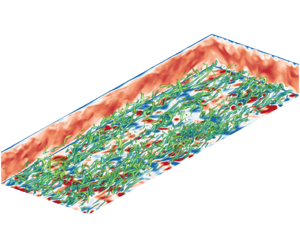Article contents
Analysis of wall-pressure fluctuation sources from direct numerical simulation of turbulent channel flow
Published online by Cambridge University Press: 08 July 2020
Abstract

The sources of wall-pressure fluctuations in turbulent channel flow are studied using a novel framework. The wall-pressure power spectral density (PSD)  $(\unicode[STIX]{x1D719}_{pp}(\unicode[STIX]{x1D714}))$ is expressed as an integrated contribution from all wall-parallel plane pairs,
$(\unicode[STIX]{x1D719}_{pp}(\unicode[STIX]{x1D714}))$ is expressed as an integrated contribution from all wall-parallel plane pairs,  $\unicode[STIX]{x1D719}_{pp}(\unicode[STIX]{x1D714})=\int _{-\unicode[STIX]{x1D6FF}}^{+\unicode[STIX]{x1D6FF}}\int _{-\unicode[STIX]{x1D6FF}}^{+\unicode[STIX]{x1D6FF}}\unicode[STIX]{x1D6E4}(r,s,\unicode[STIX]{x1D714})\,\text{d}r\,\text{d}s$, using the Green’s function. Here,
$\unicode[STIX]{x1D719}_{pp}(\unicode[STIX]{x1D714})=\int _{-\unicode[STIX]{x1D6FF}}^{+\unicode[STIX]{x1D6FF}}\int _{-\unicode[STIX]{x1D6FF}}^{+\unicode[STIX]{x1D6FF}}\unicode[STIX]{x1D6E4}(r,s,\unicode[STIX]{x1D714})\,\text{d}r\,\text{d}s$, using the Green’s function. Here,  $\unicode[STIX]{x1D6E4}(r,s,\unicode[STIX]{x1D714})$ is termed the net source cross-spectral density (CSD) between two wall-parallel planes,
$\unicode[STIX]{x1D6E4}(r,s,\unicode[STIX]{x1D714})$ is termed the net source cross-spectral density (CSD) between two wall-parallel planes,  $y=r$ and
$y=r$ and  $y=s$ and
$y=s$ and  $\unicode[STIX]{x1D6FF}$ is the half-channel height. Direct numerical simulation data at friction Reynolds numbers of 180 and 400 are used to compute
$\unicode[STIX]{x1D6FF}$ is the half-channel height. Direct numerical simulation data at friction Reynolds numbers of 180 and 400 are used to compute  $\unicode[STIX]{x1D6E4}(r,s,\unicode[STIX]{x1D714})$. Analysis of the net source CSD,
$\unicode[STIX]{x1D6E4}(r,s,\unicode[STIX]{x1D714})$. Analysis of the net source CSD,  $\unicode[STIX]{x1D6E4}(r,s,\unicode[STIX]{x1D714})$ reveals that the location of dominant sources responsible for the premultiplied peak in the power spectra at
$\unicode[STIX]{x1D6E4}(r,s,\unicode[STIX]{x1D714})$ reveals that the location of dominant sources responsible for the premultiplied peak in the power spectra at  $\unicode[STIX]{x1D714}^{+}\approx 0.35$ (Hu et al., AIAA J., vol. 44, 2006, pp. 1541–1549) and the wavenumber spectra at
$\unicode[STIX]{x1D714}^{+}\approx 0.35$ (Hu et al., AIAA J., vol. 44, 2006, pp. 1541–1549) and the wavenumber spectra at  $\unicode[STIX]{x1D706}^{+}\approx 200$ (Panton et al., Phys. Rev. Fluids, vol. 2, 2017, 094604) are in the buffer layer at
$\unicode[STIX]{x1D706}^{+}\approx 200$ (Panton et al., Phys. Rev. Fluids, vol. 2, 2017, 094604) are in the buffer layer at  $y^{+}\approx 16.5$ and 18.4 for
$y^{+}\approx 16.5$ and 18.4 for  $Re_{\unicode[STIX]{x1D70F}}=180$ and 400, respectively. The contribution from a wall-parallel plane (located at distance
$Re_{\unicode[STIX]{x1D70F}}=180$ and 400, respectively. The contribution from a wall-parallel plane (located at distance  $y^{+}$ from the wall) to wall-pressure PSD is log-normal in
$y^{+}$ from the wall) to wall-pressure PSD is log-normal in  $y^{+}$ for
$y^{+}$ for  $\unicode[STIX]{x1D714}^{+}>0.35$. A dominant inner-overlap region interaction of the sources is observed at low frequencies. Further, the decorrelated features of the wall-pressure fluctuation sources are analysed using spectral proper orthogonal decomposition (POD). Instead of the commonly used
$\unicode[STIX]{x1D714}^{+}>0.35$. A dominant inner-overlap region interaction of the sources is observed at low frequencies. Further, the decorrelated features of the wall-pressure fluctuation sources are analysed using spectral proper orthogonal decomposition (POD). Instead of the commonly used  $L^{2}$ inner product, we require the modes to be orthogonal in an inner product with a symmetric positive definite kernel. Spectral POD supports the case that the net source is composed of two components – active and inactive. The dominant spectral POD mode that comprises the active part contributes to the entire wall-pressure PSD. The suboptimal spectral POD modes that constitute the inactive portion do not contribute to the PSD. Further, the active and inactive parts of the net source are decorrelated because they stem from different modes. The structure represented by the dominant POD mode at the premultiplied wall-pressure PSD peak inclines in the downstream direction. At the low-frequency linear PSD peak, the dominant mode resembles a large scale vertical pattern. Such patterns have been observed previously in the instantaneous contours of rapid pressure fluctuations by Abe et al. (2005, Fourth International Symposium on Turbulence and Shear Flow Phenomena, Begel House Inc.).
$L^{2}$ inner product, we require the modes to be orthogonal in an inner product with a symmetric positive definite kernel. Spectral POD supports the case that the net source is composed of two components – active and inactive. The dominant spectral POD mode that comprises the active part contributes to the entire wall-pressure PSD. The suboptimal spectral POD modes that constitute the inactive portion do not contribute to the PSD. Further, the active and inactive parts of the net source are decorrelated because they stem from different modes. The structure represented by the dominant POD mode at the premultiplied wall-pressure PSD peak inclines in the downstream direction. At the low-frequency linear PSD peak, the dominant mode resembles a large scale vertical pattern. Such patterns have been observed previously in the instantaneous contours of rapid pressure fluctuations by Abe et al. (2005, Fourth International Symposium on Turbulence and Shear Flow Phenomena, Begel House Inc.).
- Type
- JFM Papers
- Information
- Copyright
- © The Author(s), 2020. Published by Cambridge University Press
References
- 15
- Cited by




